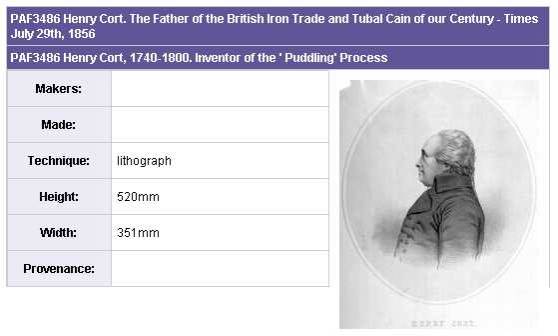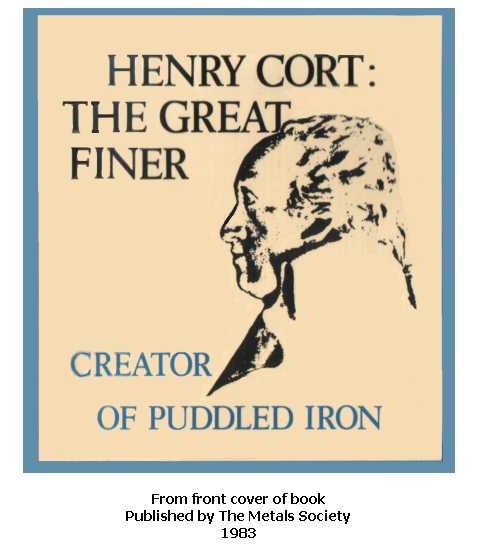 |
 |
Henry Cort Inventor - Creator of puddled iron - Father of iron trade |
 |
 |
| This page is part of a website based on the life and achievements of eighteenth-century inventor Henry Cort. The creator and owner of the site was Eric Alexander who passed away. The site is now hosted by Geneagraphie.com Please contact us with any comments or queries. |
- Homepage
- Life of Henry Cort
- Cort's processes in iron manufacture
- Cort's patents
- Refutation of allegations of conspiracies against Cort
- Adam Jellicoe's death
- Henry Cort's birth
- A navy agent's business
- Early life of John Becher
- Attwick & Burges families
- "Cortship" of second wife
- Thomas Morgan
- Henry Cort's hoops contract
- 1856 Accolade
- Generosity of friends 1789-94
- James Watson
- Illness of Cort's son
- Main sources of information
- Contemporary sources
- Navy sources
- Chancery files
- Publications about Cort
- Assessment of Cort's character
- Images of Henry Cort
Impeach-tranferred to 05
- Parliamentary inquiry 1811-2
- The furore of the 1850s
- Society of Arts
- Cort's first marriage
- Henry Cort's children
- Cort family pensions
- Henry Cort's Hertfordshire property
- 1791 signatories
- Guiana and the Cort-Gladstone connection
- Cort's twilight years
- Memorials to Henry Cort
- Smelting of iron
- Fining before Cort
- Shropshire & Staffordshire ironmasters
- Cumbrians: Wilkinson etc
- Early works at Merthyr Tydfil
- The Crowley business
- London ironmongers
- Scottish iron
- Cort's promotion efforts 1783-6
- Later Merthyr connections
- Puddling after Henry Cort
- Gosport in Cort's day
- Gosport administration
- Gosport worthies
- The Amherst-Porter network
- James Hackman, murderer
- Samuel Marshall
- Samuel Jellicoe's legacy
- Links with Titchfield
- Links with Fareham
- Fact, error and conjecture
- 18th century politics
- Law in the 18th century
- 18th century finance
- Religion and sexual mores
- Calendar change of 1752
- Shelburne, Parry and associates
- John Becher's family
- The Becher-Thackeray lineage
- Thomas Lyttelton: a fantastic narrative
- Eighteenth-century London
- Abolition and the Corts
- The Burges will tangle
- Navy connections
- Navy agent's business
- Cort's clients
- Ships' pursers
- History of Adam Jellicoe
- Dundas & Trotter
- Cort's navy office associates
- Toulmin & other agents
- Sandwich & Middleton
- The Arethusa
- John Becher's war
- Thomas Morgan's war
- The 1782 Jamaica convoy
- Sinking of the Royal George
- Visitors 2006-2009
- Developement of the site 2006-2009
- Daniel Guion and family
- Extremely bad academic work and extremely bad journalism
****************
|
|
IMAGES OF HENRY CORT
All those seen show profile, facing left.
Mezzotint
Now in British Museum annex near Olympia, open one morning every two weeks.
Probably the original likeness.
Inscribed with quotation from The Times.
|
To the Iron Trade of Great Britain This Portrait of the late HENRY CORT The TUBAL CAIN of our century & of our country THE FATHER OF THE BRITISH IRON TRADE - Times July 29th 1856 Caption below mezzotint |
Henry Cort b 1749 d 1800 Iron Master inventor of the puddling process Caption, reverse side of mezzotint |
The stamp on the reverse side shows the picture was given to the museum in 1931.
Lithograph 1
 Also in British Museum annex.
Also in British Museum annex.
Probably derived from mezzotint, though the appearance is quite different. Caption also quotes the 1856 Times article.
Adam White, I have learned from the Web, "was an Assistant in the Zoology Department of the British Museum from 1835 to 1863, specializing in Crustacea and insects." The year, 1859, in which he donates the lithograph to the museum is towards the end of the period of controversy about Henry Cort. Although there is no mention of the Society of Arts (the main source of this controversy) in White's biography, it is likely he knows many of its members. In particular, William Benjamin Carpenter, who has married Cort's granddaughter, works in a related field.
Lithograph 2

Discovered on the Web in October 2008. In National Maritime Museum, Greenwich.
Lithograph 2
Provenance and derivations unknown.
Steel engraving
Present whereabouts unkown. Possibly in archives, Institute of Materials.
Probably derived from mezzotint.
According to Mott's notes in the Coalbrookdale collection, it was presented by William Fairbairn and others to the Cort Memorial Fund set up in 1856.
According to a letter from Charles H. Morgan (to H.H. Suplee, January 24, 1906), it was subsequently "presented to the Iron and Steel Institute by Windsor Richards in 1901". The Institute was later subsumed into the Metals Society, then into the Institute of Materials.
The letter also says Morgan has "a good enlarged copy of the Steel Engraving of Henry Cort which I would be glad to donate to the A.S.M.E." (American Society of Mechanical Engineers). Does ASME now hold this copy?
Model and bronze bas-reliefs
|
We owe the tablet to an eminent American engineer, who is much impressed with the value of the work Cort did for the world and wishes to rescue his name from an undeserved oblivion. It is a bronze tablet showing Cort's head in good relief. The American donor, who desires to keep his own name back, intends to place a replica of the tablet in Lancaster Parish Church. At the unveiling ceremony he was represented by Mr. J.P. Bedson, of Manchester. From Manchester Guardian, 10 March 1905. |
We now know that the American engineer is Charles H Morgan.
One bronze is at St Johns Hampstead, where Cort is buried.
The other is at St Marys Lancaster. near where he is said to have been born. Weale quotes his birthplace as Ellell, which Mott discovered is in the parish of Cockerham near Lancaster.
Mott says the two bronzes were developed from the original steel engraving. According to the Morgan-Suplee letter, an intermediate stage was "the model from which the Copham Manufacturing Company made the Bronze Tablets", which was then in Morgan's possession.
Plaster cast
At Manchester Materials Science Centre.
|
The Manchester side of the 1905-6 operation took place on Tuesday 6th February 1906 in the Schunck laboratory, when Mr. Bedson presented to the University a plaster cast of the original bronze tablet. This cast, which is now in room F1 of the new Metallurgy Building, shows Henry Cort in profile and is inscribed IN MEMORY OF HENRY CORT BORN AT LANCASTER 1740 INTERRED AT HAMPSTEAD 1800 TO WHOM THE WORLD IS INDEBTED FOR THE ARTS OF REFINING IRON WITH MINERAL COAL BY PUDDLING AND ROLLING METALS IN GROOVED ROLLS. From commemorative leaflet for University of Manchester Open Day, 20 May 1978. |
Evidently also developed from steel engraving.
Book cover
The image on the front cover of the Mott/Singer book Henry Cort: The Great Finer was probably taken from the original steel engraving, since the book was published by The Metals Society

Fareham images
The image used on the flags for Fareham's commemoration of Henry Cort, April-June 2000, was evidently taken from the book: probably from the photograph of the Hampstead tablet rather than the cover.

Website image
The image used in the banner on this and several other pages off this website was developed from a photograph by Eric Alexander of the Lancaster tablet.
|
Related pages |
The pages on this site are copied from the original site of Eric Alexander (henrycort.net) with his allowance.
Eric passed away abt 2012
If you use/copy information from this site, please include a link to the page where you found the information.
